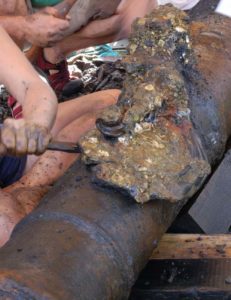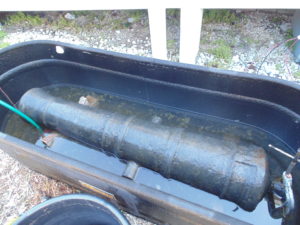On Wednesday, October 7, 2015, we will begin the final phase of conservation for the two large cannons from the Storm wreck.
Lighthouse archaeologists excavated the guns in June, 2011, and brought them to the lighthouse. In the first phase of conservation, as much of the exterior concretion as possible was removed using hammers, chisels and air-scribes. This was to ensure no other artifacts were stuck inside the concretion, and if there were any, that they would be treated and conserved separately. It was also necessary to remove the extraneous material to speed up the second phase.
When the cannons were cleaned off, they were placed in metal tanks to undergo electrolytic reduction (ER). In ER, the gun is submerged in a solution of reverse osmosis water and sodium carbonate. Sheets of expanded steel mesh were placed on the sides of the cannon and connected to a positive electrical anode. The cannon itself is connected to the negative anode.
By drawing the electrical charge into the gun, we can very gradually and safely extract the salt (built up over 230 years in a marine environment) out of the cast iron and into the solution. The solution is periodically replaced and refilled so that, over the months and years, the chloride content of the cannons is reduced to as low as possible. This is the main concern for conserving marine artifacts. If the salt is not removed, the material will continue to corrode and break apart from the inside out.
After nearly four years of ER treatment, the cannons are now ready to come out and move to the third phase.
The 4-pound long gun will be the first to be removed. We will drain the solution, lift the cannon out of its current tank with our engine hoist and gantry and be wheeled over to our secured conservation facility for safety precautions. The cannon will then be lifted and placed into a new metal tank and submerged in reverse osmosis water. The water and gun will be heated for an extended period of time to rinse the artifact. This will open the pores of the cast iron and help remove any final unwanted soluble salts and any extra sodium carbonate solution. The rinsing should take one to two weeks with occasional water bath changes. We will take samples of the water to ensure as much salt is removed as possible before the final sealing phase.
Andrew Thomson is the Assistant Conservator for the St. Augustine Lighthouse & Museum. He received his graduate degree and training from the Conservation Research Laboratory at Texas A&M.



